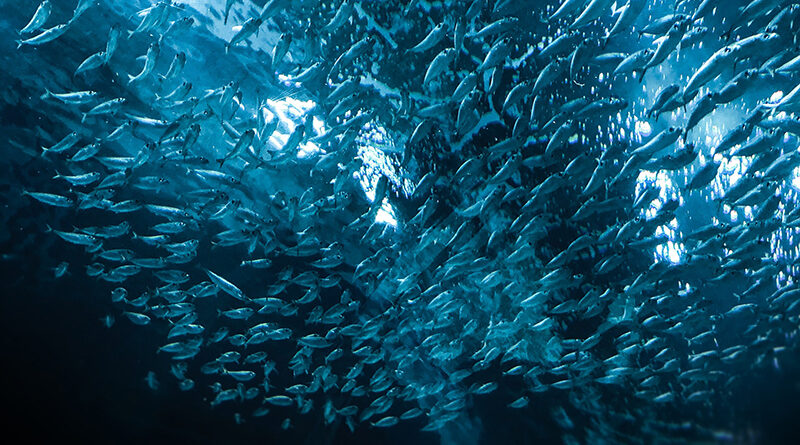Sardine Populations and Fisheries Harvest Control Rules May Need to Respond to Climate Change
A new study examines how climate change could affect West Coast sardines and considers how well-fishing rules and dynamic management will work when ocean conditions change.
According to the National Oceanic and Atmospheric Administration (NOAA), sardines have been managed under a harvest control rule linked to average sea-surface temperatures, which are believed to influence sardine numbers. The rule is to modify catch limits as temperatures vary. However, there are now signs of climate-driven changes in the productivity of the West Coast offshore ecosystem that may also impact sardine numbers.
Sardines are highly sensitive to environmental conditions, and changes in ocean temperature, acidity and other factors associated with climate change can influence their distribution, abundance, and overall health.
Sardines are beneficial to California’s economy. The sardine fishery supports the fishing industry as a whole, including commercial fishermen, processors and distributors. Additionally, the sardine industry offers employment opportunities for individuals in fishing operations, seafood processing plants, transportation and distribution, including fishermen, fish processors, drivers and other workers along the supply chain. Sardines also benefit the seafood industry, and some coastal cities host events such as the Sardine Festival in San Jose, generating tourism.
Scientists at NOAA Fisheries’ Southwest Fisheries Science Center assessed whether management measures for the sardine fishery still will be effective if climate change alters the productivity of the species.
“The goal as climate change continues is to develop information and tools that help fishery managers stay on top of the changes,” said Robert Wildermuth, lead author of the new management strategy evaluation for the West Coast sardine fishery, in a news release.
The evaluation tests different strategies by modeling how they would play out under varying conditions, including shifts in ocean conditions accompanying climate change.
NOAA has stated that recruitment drives the change. Recruitment refers to how many young sardines survive to join the population as reproducing adults, affecting the population’s course. That then affects how much fishing the population can support. Most sardine fisheries off the West Coast have been closed since 2015. The number and size of the fish – collectively known as biomass – have fallen below the current harvest control-rule cutoff, forcing the fishery’s closure.
Wildermuth and NOAA Fisheries colleagues at the Southwest and Northwest Fisheries Science Centers collaborated with University of California Santa Cruz scientists to study nine ways of setting the harvest control rule for sardines off the West Coast under different future recruitment scenarios. The research is part of Future Seas, a collaboration between scientists at NOAA Fisheries and other organizations. It examines strategies for managing fisheries as climate change affects the California Current off the West Coast.
The evaluation was recently published in the Canadian Journal of Fisheries and Aquatic Sciences. The report reads:
“We’re trying to look at the different ways climate change will affect fisheries and ask, ‘How do we maintain sustainable fisheries when the environment is changing around us,'” said Annie Yau, Director of the Fisheries Resources Division at the Southwest Fisheries Science Center.
Sardine fluctuations are intertwined with California history, fueling the boom and subsequent bust of Cannery Row in Monterey in the 1950s. Researchers have long probed the factors behind the rise and fall of sardine numbers. They have tied sardine fluctuations to oceanic conditions, such as the Pacific Decadal Oscillation. That climate pattern can drive warm and cool phases of Pacific Ocean waters that have been found to affect many species, including salmon. Recent research has also found links to food availability.
Dynamic Drivers
Wildermuth’s team looked at sardine management options that included the current method, which is tied to sea-surface temperatures. They also considered using dynamic reference points for the population to determine changes in harvest. Usually, the reference points assume a static amount of recruitment. However, they can also be “dynamically estimated,” which means that they fluctuate according to changes in recruitment or sardine biomass. They found that this approach that adjusts over time better reflected changing conditions and reduced the odds that the fishery would close.
The approach does not identify exactly what factors affect sardine biomass. However, the annual adjustments in reference points help capture patterns and relationships between ocean conditions and reproductive capacity over time, independent of fishing. That better reflects how biomass fluctuates with changing ocean conditions. Incorporating that relationship into the harvest control rule leads to a more stable fishery with fewer closures.
“We get a more realistic picture of both the biomass and how it may [change] over time,” Wildermuth said.
NOAA Fisheries’ annual California Current Ecosystem surveys regularly measure the biomass of coastal pelagic species such as sardines to support fishery management decisions. Catch records also supplement the survey data.
“These data are essential to the stock assessments, which are developed to track changes in the sardine population through time,” said Desiree Tommasi, a co-author in the study. “Thus, to continue [effectively managing sardines] under changing ocean conditions, it is also essential to maintain NOAA’s survey efforts into the future.”
Key findings from the study include:
- The current survey and assessment process can track changes in the population status of sardines.
- Harvest control rules responsive to environmentally driven changes can improve outcomes compared to static management.
- Management success may depend more on understanding and modeling drivers of climate-driven recruitment dynamics than refining harvest control rule functions.
- As new information on climate-driven changes in recruitment dynamics becomes available, future studies can use this tool to evaluate their value for management decision-making and near-term stock forecasting.
Future Seas and other NOAA Fisheries initiatives to develop “Climate Ready Fisheries” seek new means to support management. That includes new methods of collecting and analyzing data to help guide real-time changes in fishery management.
For more information, please visit https://www.fisheries.noaa.gov/.


